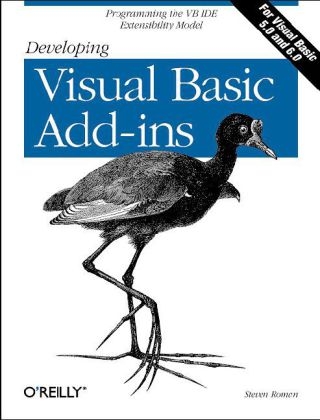
Developing Visual Basic Add-ins
O'Reilly Media (Verlag)
978-1-56592-527-4 (ISBN)
- Titel ist leider vergriffen;
keine Neuauflage - Artikel merken
Most developers can think of dozens of ways in which they'd like to modify Visual Basic's integrated development environment (or IDE) in order to work more productively. These enhancements can range from simple items (like determining the version of Visual Basic for Applications used by the IDE, or clearing the Immediate window) to much more involved ones (like developing a utility that allows the tab order of the individual controls on a form to be set easily). Just as the major Microsoft Office applications expose their functionality through their object models, Visual Basic's development environment also exposes its functionality through the Visual Basic Extensibility Model. Unfortunately, though, the model is poorly documented and poorly understood. And most programmers simply don't have the time to sift through the documentation and experiment using trial and error to extend the IDE. This text addresses this lack of documentation by showing how to develop add-ins for Visual Basic Versions 5.0 and 6.0 and by providing numerous coding examples of simple but useful add-ins. The book is divided into two parts.
The first part, Add-in Basics, discusses the mechanics of add-in creation. This includes such topics as: retrieving a reference to the VB IDE; registering an add-in; activating an add-in; making an add-in's functionality accessible through a menu option or toolbar button; and debugging an add-in. Developing an add-in requires creativity, since it requires a programmer to both identify a shortcoming of the IDE and implement some means of enhancing it. The second part of the book, The Extensibility Model, prepares you for this creative part of add-in development by focusing on the VB IDE Extensibility Model. Individual chapters provide in-depth coverage of specific categories of objects, such as user interface objects, project-related objects, and form and control objects.
Steven Roman is Professor Emeritus of mathematics at the California State University, Fullerton. He has taught at a number of other universities, including MIT, the University of California at Santa Barbara, and the University of South Florida. Dr. Roman received his B.A. degree from the University of California at Los Angeles and his Ph.D. from the University of Washington. Dr. Roman has authored 32 books, including a number of books on mathematics, such as Coding and Information Theory, Advanced Linear Algebra, and Field Theory, published by Springer-Verlag. He has also written a series of 15 small books entitled Modules in Mathematics, designed for the general college-level liberal arts student. Besides his books for O'Reilly (Access Database Design & Programming, Learning Word Programming, Writing Excel Macros, Developing Visual Basic Add-Ins, Win32 API Programming with Visual Basic [in production]), Dr. Roman has written two other computer books, entitled Concepts of Object-Oriented Programming with Visual Basic and Understanding Personal Computer Hardware, an in-depth look at how PC hardware works, both published by Springer-Verlag. Dr. Roman is interested in combinatorics, algebra, and computer science.
Part I Add-in basics: the basic components of an add-in; object models; menus and toolbars; debugging add-ins. Part II The extensibility model: overview of the object model; user interface objects; project-related objects; form and control objects; event-related objects; code-related objects; add-in related objects. Appendices: built-in command bar controls; face IDs.
| Erscheint lt. Verlag | 9.2.1999 |
|---|---|
| Verlagsort | Sebastopol |
| Sprache | englisch |
| Maße | 178 x 232 mm |
| Gewicht | 360 g |
| Einbandart | kartoniert |
| Themenwelt | Informatik ► Programmiersprachen / -werkzeuge ► Visual Basic |
| ISBN-10 | 1-56592-527-0 / 1565925270 |
| ISBN-13 | 978-1-56592-527-4 / 9781565925274 |
| Zustand | Neuware |
| Haben Sie eine Frage zum Produkt? |
aus dem Bereich
